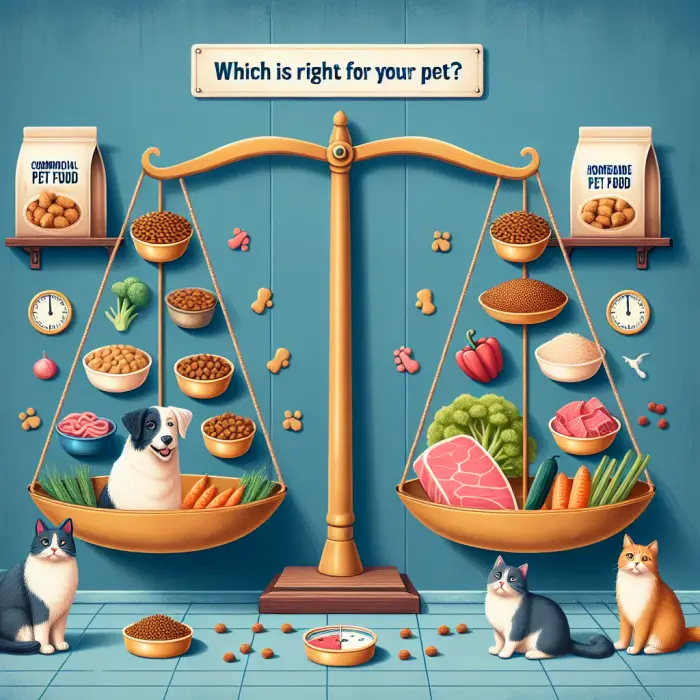
Image about pets.
Choosing the right diet for your beloved pet can be a daunting task, but have you ever wondered whether homemade or commercial pet food is the better option?
This article delves into the essential nutritional needs of various pets, from dogs to cats, and explores the benefits and drawbacks of both homemade and commercial pet food.
We’ll examine the cost implications, safety concerns, and quality control measures to help you make an informed decision.
Whether you’re considering the convenience of store-bought options or the customization of homemade meals, our comprehensive guide will provide you with the insights needed to ensure your pet’s health and happiness.
Join us as we navigate this important aspect of pet care, and feel free to share your experiences and thoughts along the way.
Understanding Your Pet’s Nutritional Needs
When it comes to your pet’s diet, understanding their nutritional needs is crucial. Different pets, such as dogs and cats, have unique requirements that must be met to ensure their health and well-being.
Essential nutrients like proteins, fats, vitamins, and minerals play a significant role in their overall health. For instance, proteins are vital for growth and repair, while fats provide energy and support cell function.
Vitamins and minerals are necessary for various bodily functions, including immune support and bone health.
These nutritional needs can vary significantly based on factors such as age, breed, and health condition.
For example, a puppy or kitten requires more protein and fat compared to an adult or senior pet. Similarly, certain breeds may have specific dietary needs; for instance, large-breed dogs often need diets that support joint health.
Pets with health conditions like diabetes or kidney disease may require specialized diets to manage their conditions effectively.
| Pet Category | Proteins | Fats | Vitamins & Minerals |
|---|---|---|---|
| Dogs | High (20-30%) | Moderate (10-15%) | Balanced |
| Cats | Very High (30-40%) | High (15-20%) | Balanced |
| Puppies/Kittens | Very High (30-40%) | High (15-20%) | Extra Vitamins |
| Senior Pets | Moderate (15-20%) | Low (5-10%) | Extra Minerals |
Understanding these nutritional requirements helps you make informed decisions about your pet’s diet, whether you opt for homemade or commercial pet food. Tailoring their diet to meet these needs ensures they stay healthy and thrive at every stage of their life.
Benefits and Drawbacks of Homemade Pet Food
When it comes to feeding your furry friend, the debate between homemade pet food and commercial options is hotter than ever.
Let’s dive into the nitty-gritty of why some pet owners swear by homemade diets and why others find them a bit of a hassle.
One of the biggest perks of homemade pet food is the control over ingredients. You know exactly what goes into your pet’s bowl, which is a game-changer if your pet has allergies or dietary restrictions.
Plus, you can customize meals to suit your pet’s specific needs, whether they need more protein, fewer carbs, or a special blend of vitamins.
But let’s not sugarcoat it—there are some significant drawbacks. First off, making your pet food is a serious time commitment.
Between shopping for ingredients, cooking, and ensuring everything is balanced, it can feel like a part-time job.
And speaking of balance, there’s always the risk of nutritional imbalance. Without proper knowledge, you might miss out on essential nutrients that your pet needs to thrive.
Here are some real-life examples from pet owners who have tried homemade diets:
- Sarah from London: Switching to homemade food helped my dog with his allergies, but it took a lot of research and trial and error to get it right.
- Mike from Manchester: I love knowing exactly what my cat is eating, but the prep work is exhausting. Sometimes I wonder if it’s worth it.
For easy readability, here are the pros and cons:
- Pros: Full control over ingredients, customization for dietary needs, potential for better quality.
- Cons: Time-consuming, risk of nutritional imbalance, requires extensive research.
Evaluating Commercial Pet Food Options
When it comes to choosing commercial pet food, there are several types to consider: dry, wet, raw, and semi-moist.
Each type has its own set of benefits and drawbacks. For instance, dry food is incredibly convenient and often more affordable, but it can contain preservatives that some pet owners prefer to avoid.
Wet food, on the other hand, offers higher moisture content, which is great for hydration but can be more expensive and less convenient to store. Raw food is praised for its natural ingredients but requires careful handling to avoid contamination.
Semi-moist food strikes a balance between dry and wet but often includes artificial flavors and preservatives.
One of the main advantages of commercial pet food is its nutritional balance. Reputable brands invest in research to ensure their products meet the dietary needs of pets.
However, it’s crucial to read labels carefully. Look for brands that list specific meat sources (like chicken or beef) rather than vague terms like meat by-products.
Brands such as Royal Canin, Hill’s Science Diet, and Blue Buffalo are often recommended by veterinarians for their quality ingredients and balanced nutrition.
| Type | Benefits | Drawbacks | Examples |
|---|---|---|---|
| Dry | Convenient, Affordable | Contains Preservatives | Royal Canin, Hill’s Science Diet |
| Wet | High Moisture Content | Expensive, Less Convenient to Store | Blue Buffalo, Wellness |
| Raw | Natural Ingredients | Requires Careful Handling | Stella & Chewy’s, Primal Pet Foods |
| Semi-Moist | Balanced Between Dry and Wet | Includes Artificial Flavours | Purina Moist & Meaty, Kibbles ‘n Bits |
Cost Comparison: Homemade vs. Commercial Pet Food
When it comes to the costs associated with homemade and commercial pet food, many pet owners find themselves at a crossroads.
On one hand, homemade pet food can seem like a more economical option, especially if you’re using ingredients you already have at home.
However, the reality is often more complex. Ingredients for homemade pet food can add up quickly, especially if you’re aiming for a balanced diet that includes high-quality proteins, vegetables, and supplements.
For example, a week’s worth of homemade meals for a medium-sized dog might cost around £20-£30, depending on the ingredients used.
On the other hand, premium commercial pet food brands can be quite pricey, but they offer the convenience of being nutritionally balanced and ready to serve.
A high-quality commercial pet food brand might set you back around £40-£60 per month for the same medium-sized dog. However, it’s essential to consider the hidden costs associated with each option.
Homemade pet food requires significant time investment for meal prep and cooking, and there’s always the risk of nutritional imbalances that could lead to potential vet bills.
Experts advise that while homemade diets can be beneficial, they must be carefully planned to meet all of your pet’s nutritional needs.
| Expense | Homemade Pet Food | Commercial Pet Food |
|---|---|---|
| Weekly Cost | £20-£30 | £10-£15 |
| Monthly Cost | £80-£120 | £40-£60 |
| Hidden Costs | Time, Potential Vet Bills | Minimal |
Safety and Quality Control
When it comes to pet food, safety and quality control are paramount. Homemade pet food can be a fantastic option, but it comes with its own set of challenges.
One of the primary concerns is ensuring that you’re sourcing high-quality ingredients. Unlike commercial options, homemade recipes don’t go through rigorous testing, so it’s crucial to know where your ingredients are coming from.
Always opt for organic and non-GMO products to ensure the best for your furry friend.
On the other hand, commercial pet food is subject to strict regulations. These products often come with certifications such as AAFCO (Association of American Feed Control Officials) approval, which ensures that the food meets specific nutritional standards. However, not all commercial foods are created equal.
Look for brands that use natural ingredients and avoid those with fillers and artificial additives.
- For homemade food, always consult with a veterinarian to ensure a balanced diet.
- Store ingredients properly to avoid contamination.
- For commercial food, check for recalls and read reviews.
- Always transition your pet’s diet gradually to avoid digestive issues.
In conclusion, both homemade and commercial pet foods have their pros and cons. The key is to stay informed and make choices that prioritize the health and well-being of your pet.
Making the Right Choice for Your Pet
Deciding between homemade and commercial pet food can be a daunting task, but it’s crucial to consider your pet’s individual needs.
Factors like lifestyle, budget, and specific health conditions play a significant role in this decision. For instance, if your pet has allergies or digestive issues, a homemade diet might offer more control over ingredients.
On the other hand, commercial pet food is often more convenient and can be tailored to meet nutritional standards.
To help you make an informed decision, follow this step-by-step guide to transition your pet to a new diet. First, consult your veterinarian to understand your pet’s specific nutritional requirements.
Next, gradually introduce the new food over 7-10 days to avoid digestive upset. Start by mixing a small amount of the new food with the old one, gradually increasing the proportion of the new food. Monitor your pet for any signs of discomfort or allergic reactions.
By considering these factors and following a structured approach, you can ensure that your pet’s diet is both nutritious and suitable for their unique needs.
